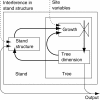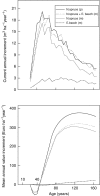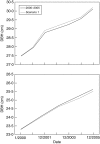Models for forest ecosystem management: a European perspective
- PMID: 17954471
- PMCID: PMC2710278
- DOI: 10.1093/aob/mcm246
Models for forest ecosystem management: a European perspective
Abstract
Background: Forest management in Europe is committed to sustainability. In the face of climate change and accompanying risks, however, planning in order to achieve this aim becomes increasingly challenging, underlining the need for new and innovative methods. Models potentially integrate a wide range of system knowledge and present scenarios of variables important for any management decision. In the past, however, model development has mainly focused on specific purposes whereas today we are increasingly aware of the need for the whole range of information that can be provided by models. It is therefore assumed helpful to review the various approaches that are available for specific tasks and to discuss how they can be used for future management strategies.
Scope: Here we develop a concept for the role of models in forest ecosystem management based on historical analyses. Five paradigms of forest management are identified: (1) multiple uses, (2) dominant use, (3) environmentally sensitive multiple uses, (4) full ecosystem approach and (5) eco-regional perspective. An overview of model approaches is given that is dedicated to this purpose and to developments of different kinds of approaches. It is discussed how these models can contribute to goal setting, decision support and development of guidelines for forestry operations. Furthermore, it is shown how scenario analysis, including stand and landscape visualization, can be used to depict alternatives, make long-term consequences of different options transparent, and ease participation of different stakeholder groups and education.
Conclusions: In our opinion, the current challenge of forest ecosystem management in Europe is to integrate system knowledge from different temporal and spatial scales and from various disciplines. For this purpose, using a set of models with different focus that can be selected from a kind of toolbox according to particular needs is more promising than developing one overarching model, covering ecological, production and landscape issues equally well.
Figures















References
-
- Aber JD, Federer CA. A generalized, lumped parameter model of photosynthesis, evaporation and net primary production in temperate and boreal forest ecosystems. Oecologia. 1992;92:463–474. - PubMed
-
- Aber JD, Ollinger SV, Federer CA, Reich PB, Goulden ML, Kicklighter DW, et al. Predicting the effects of climate change on water yield and forest production in the northeastern United States. Climate Research. 1995;5:207–222.
-
- Aber JD, Ollinger SV, Driscoll CT, Likens GE, Holmes RT, Freuder RJ, Goodale CL. Inorganic nitrogen losses from a forested ecosystem in response to physical, chemical, biotic,and climatic perturbations. Ecosystems. 2002;5:648–658.
-
- Almeida AC, Landsberg JJ, Sands PJ, Ambrogi MS, Fonseca S, Barddal SM, Bertolucci FL. Needs and opportunities for using a process-based productivity model as a practical tool in Eucalyptus plantations. Forest Ecology and Management. 2004;193:167–177.
-
- Alveteg M. Projecting regional patterns of future soil chemistry status in Swedish forests using SAFE. Water, Air, and Soil Pollution: Focus. 2004;4:49–59.
Publication types
MeSH terms
LinkOut - more resources
Full Text Sources
Miscellaneous

